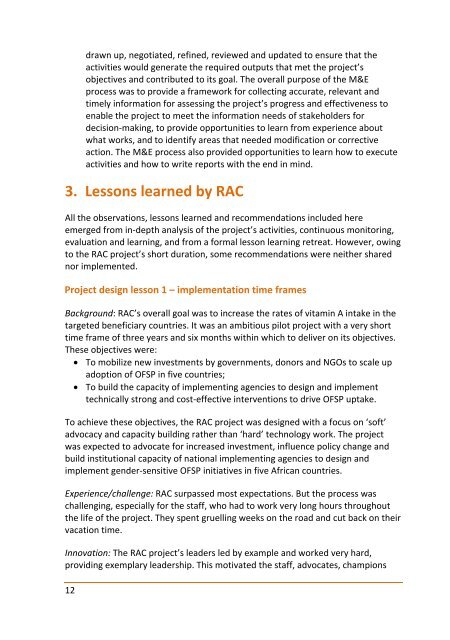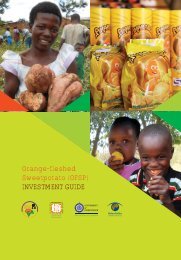Recommendation
Up89Y
Up89Y
You also want an ePaper? Increase the reach of your titles
YUMPU automatically turns print PDFs into web optimized ePapers that Google loves.
12<br />
drawn up, negotiated, refined, reviewed and updated to ensure that the<br />
activities would generate the required outputs that met the project’s<br />
objectives and contributed to its goal. The overall purpose of the M&E<br />
process was to provide a framework for collecting accurate, relevant and<br />
timely information for assessing the project’s progress and effectiveness to<br />
enable the project to meet the information needs of stakeholders for<br />
decision‐making, to provide opportunities to learn from experience about<br />
what works, and to identify areas that needed modification or corrective<br />
action. The M&E process also provided opportunities to learn how to execute<br />
activities and how to write reports with the end in mind.<br />
3. Lessons learned by RAC<br />
All the observations, lessons learned and recommendations included here<br />
emerged from in‐depth analysis of the project’s activities, continuous monitoring,<br />
evaluation and learning, and from a formal lesson learning retreat. However, owing<br />
to the RAC project’s short duration, some recommendations were neither shared<br />
nor implemented.<br />
Project design lesson 1 – implementation time frames<br />
Background: RAC’s overall goal was to increase the rates of vitamin A intake in the<br />
targeted beneficiary countries. It was an ambitious pilot project with a very short<br />
time frame of three years and six months within which to deliver on its objectives.<br />
These objectives were:<br />
To mobilize new investments by governments, donors and NGOs to scale up<br />
adoption of OFSP in five countries;<br />
To build the capacity of implementing agencies to design and implement<br />
technically strong and cost‐effective interventions to drive OFSP uptake.<br />
To achieve these objectives, the RAC project was designed with a focus on ‘soft’<br />
advocacy and capacity building rather than ‘hard’ technology work. The project<br />
was expected to advocate for increased investment, influence policy change and<br />
build institutional capacity of national implementing agencies to design and<br />
implement gender‐sensitive OFSP initiatives in five African countries.<br />
Experience/challenge: RAC surpassed most expectations. But the process was<br />
challenging, especially for the staff, who had to work very long hours throughout<br />
the life of the project. They spent gruelling weeks on the road and cut back on their<br />
vacation time.<br />
Innovation: The RAC project’s leaders led by example and worked very hard,<br />
providing exemplary leadership. This motivated the staff, advocates, champions



